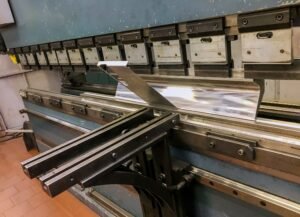Metal Bending
Our metal folding services are equipped with advanced electric and hydraulic press brakes, making them perfectly suited for a wide range of manufacturing needs. These state-of-the-art machines enable us to handle both large-scale production runs and smaller, one-off jobs with equal efficiency and precision.
Tailored to your specific designs, our metal folding process ensures accurate bending and shaping of metal sheets, resulting in components that precisely match your specifications. Whether for complex industrial applications or unique custom projects, our metal folding services offer the flexibility and accuracy needed to meet diverse manufacturing demands.
Different bending methods
When it comes to metal folding, a variety of bending methods are available, each suited to different requirements and types of press brake tooling. Understanding these methods can simplify the decision-making process when seeking a metal folding service.
V-Bending: The most commonly used method in metal folding, V-bending involves a punch pressing the sheet metal onto a die. It is divided into three types:
Air Bending: The sheet is not fully pressed onto the die but only partially to achieve the desired angle. This is the most prevalent form of V-bending.
Bottoming and Coining: These methods involve more direct and forceful contact with the die, resulting in more precise bends.
U-Bending: Similar to V-bending but uses a U-shaped die. It’s primarily used for creating U-channels in metal sheets.
Step Bending: This method employs successive V-bending actions to achieve large-radius bends. Smaller steps are used to assure a smoother bend quality.
Roll Bending: Roll bending differs by using rolls instead of punches and dies. It’s particularly effective for parts requiring large radii or conical shapes in sheet metal.
Rotary Bending: Known for its ability to produce angular bends without leaving bending marks (common with V-shaped dies). This method is ideal for applications requiring a pristine finish on the bent part.
Each of these bending techniques offers unique benefits, making them suitable for various metal folding tasks. Whether you need precise angles, smooth large-radius curves, or unmarked finishes, there is a bending method to meet your project’s specific needs.
Gallery




What is CNC Bending
CNC bending represents a significant advancement in metal forming, offering unparalleled precision in bending sheet metal. Utilizing state-of-the-art, computer-controlled machinery, this process automates metal bending to ensure consistent, high-quality results. Following a pre-programmed sequence, the CNC machine’s press brakes apply precise force on the metal sheet at designated locations, accurately creating the required angles and shapes.
A key advantage of CNC bending over manual methods is its precision and uniformity. Manual bending may introduce variations due to human error, whereas CNC bending machines consistently adhere to specified parameters, ensuring uniformity, especially in mass production. This technology excels in creating intricate and complex designs with high repeatability, making it ideal for sophisticated metalworking projects.
While the initial setup and programming for CNC bending may incur higher costs, this investment becomes more economical over larger production runs. For one-off or small-batch productions, these upfront costs might be less favorable compared to manual bending. However, for high-volume manufacturing, the accuracy, consistency, and efficiency of CNC bending lead to substantial long-term cost savings and quality enhancements.
What are the Metal Bending Advantages ?
While welding is inevitable in many cases and bending cannot substitute it everywhere, we recommend choosing metal bending services whenever possible. The advantages of metal folding are:
- Aesthetics – Although in engineering functionality comes first, design follows closely behind. The lack of weldments guarantees on nice visual for your project.
- Coating – A smooth surface is a great canvas for coating procedures, leaving a better result.
- Fewer mistakes – Welding needs more manual labour. Manual labour, in turn, leaves more room for mistakes. Automatic CNC bending systems provide accurate results.
- Fewer parts – It is more convenient to re-work your parts in CAD, if needed. But it’s also easier to keep your workfloor nice and tidy with a smaller number of parts laying around.
Contact
+91- 90035 99554
sales@cnve.in
Schedule a Call
